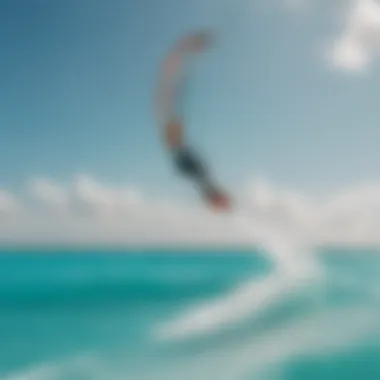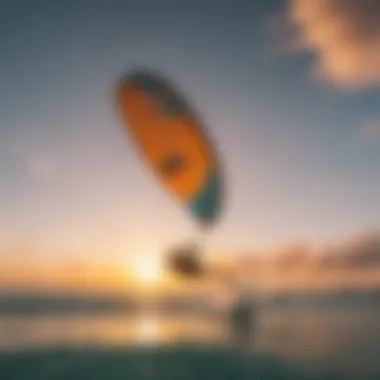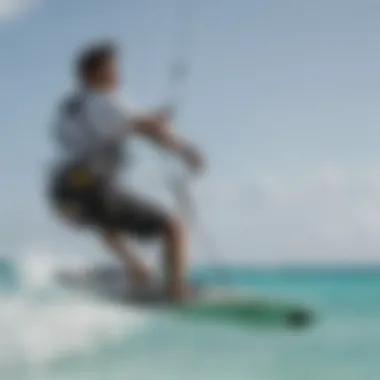Kitesurfing in the Maldives: A Complete Guide


Intro
Kitesurfing in the Maldives is more than just a sport; it’s an exhilarating blend of adventure and tranquility set against a backdrop of paradise. The crystalline waters, white sandy beaches, and consistent winds draw attention from avid kitesurfers worldwide. But what makes this archipelago stand out from other prominent kitesurfing destinations? This article unveils the unique aspects of kitesurfing here, touching on the geographical advantages, the optimal seasons, the necessary gear, and vital environmental considerations.
The Maldives is a collection of over a thousand islands, which means that kitesurfers can find their niche, whether they're just starting out or are veterans of the sport. Diving deeper into this topic can provide insights not just for kitesurfers but for anyone considering the Maldives as their next holiday spot. Critical discussions will include gear requirements tailored to these waters, the techniques that maximize the experience, and the safety norms that maintain the sport’s integrity.
In addition to technical advice, an understanding of local regulations and the vibrant community can enrich one's kitesurfing experience. Therefore, taking a look at this sport not only immerses one in the mechanics but also invites an appreciation for the local culture and environmental stewardship that defines kitesurfing in the Maldives.
Understanding Kitesurfing
Kitesurfing is not just a sport; it’s a way to connect with nature, and it offers a unique blend of thrill and serenity. In the context of the Maldives, the importance of understanding kitesurfing cannot be overstated. This tropical paradise, with its strikingly clear waters and steady winds, provides an ideal setting for both novice and experienced kitesurfers alike. Knowing the ins and outs of kitesurfing significantly enhances the overall experience, making it more enjoyable and safe for participants.
By delving deep into the elements of the sport, enthusiasts can grasp essential techniques, gear requirements, and local regulations, all of which foster a fulfilling experience on the water. For travelers looking to include kitesurfing in their Maldives itinerary, this understanding is invaluable. Not only does it prepare them to embrace the unique challenges of the sport, but it also nurtures a greater respect for the stunning marine environment in which they are immersed. With that in mind, let’s explore the roots and mechanics of kitesurfing.
History of Kitesurfing
Kitesurfing has a rather colorful history, starting from its rudimentary beginnings in the late 20th century. The concept can trace its roots back to several cultures that utilized kites for transportation on water. An interesting element to note is that in the 1970s and 1980s, pioneers began experimenting with kites, using them to propel surfboards. However, it wasn't until the 1990s, with the introduction of the first inflatable kites and the development of better boards, that kitesurfing as we know it today truly took off.
Over the years, kitesurfing evolved from a niche hobby to a globally recognized sport, firmly embedding itself in coastal cultures around the world. The first competitions sprouted in the late 90s, punctuating the growth phase that attracted attention from a more mainstream audience. Today, kitesurfing is not just about thrill-seeking; it’s a community that fosters camaraderie among enthusiasts who share a love for the waves and wind.
Mechanics of the Sport
Understanding the mechanics of kitesurfing is vital for anyone looking to hit the water. Essentially, the sport combines elements of surfing, windsurfing, and paragliding. At its core, kitesurfing relies on the wind's power to propel the surfer across the water, using a large kite to harness that force.
When it comes to the essential components, you'll find the following aspects at play:
- The Kite: This is the heart of kitesurfing. Kites come in various shapes and sizes, each designed for different wind conditions and skill levels.
- The Board: Similar to a surfboard, this is where the rider stands. Different types of boards cater to various styles, like freeride or freestyle.
- The Harness: Worn around the waist, the harness connects the rider to the kite, allowing for better control without tiring the arms too quickly.
- Safety Equipment: This includes a quick-release system on the harness and possibly a helmet or impact vest, essential for ensuring safety while performing tricks or navigating aggressive waves.
Kitesurfing relies heavily on balance, control, and timing. Learning to read the wind and understanding water dynamics can make a considerable difference in performance and enjoyment. Knowing how to manage the power of the kite is crucial—too much pull can lead to a rough ride, while too little might leave you stranded on your board.
Understanding these mechanics and the history can arm participants with not only the knowledge of how to kitesurf but also an appreciation for its evolution and impact on coastal cultures around the world.
Geographical Wonders of the Maldives
The Maldives, a tropical paradise of 26 atolls, makes it a standout location for kitesurfing. The interplay between its unique geography and favorable wind conditions crafts an environment that draws enthusiasts from across the globe. This section aims to unfold how these geographical wonders not only enrich the kitesurfing experience but also provide key insights for those looking to embrace this exhilarating sport in such an exquisite setting.
Unique Atolls and Their Impact
Each atoll in the Maldives possesses a distinct character, shaped by its formation and ecology. The archipelago’s flat coral reefs serve as natural barriers, influencing wave patterns and water depth. For kitesurfers, knowing which atolls have specific wind and wave characteristics can significantly enhance performance. The northern atolls, for instance, often feature steadier breezes, which make them ideal for both beginners and seasoned pros alike. On the other hand, some of the more southern atolls offer a mix of flatwater and wave environments, catering to a wider range of skill sets. This diversity is crucial; it means that no matter your level of experience, there’s likely a spot that suits your taste.
Wind Patterns Specific to the Region
Understanding the wind patterns in the Maldives is a fundamental aspect of planning kitesurfing trips. The region benefits from two main wind systems: the northeast monsoon from November to March and the southwest monsoon from May to October. Each of these winds comes with distinct characteristics.
- Northeast Monsoon: This season produces consistent and robust winds, ranging between 15 to 25 knots, ideal for kitesurfers looking to hone their skills in steady conditions.
- Southwest Monsoon: While this period may bring lighter winds, it also presents opportunities for those who enjoy a more relaxed kitesurfing environment, with wind speeds often in the range of 10 to 15 knots.
These patterns not only guide when to plan trips but also affect the choice of equipment and techniques suited to achieve the best performance.
Ideal Locations for Kitesurfing
Kitesurfing Hotspots
One of the most famous kitesurfing hotspots in the Maldives is Soneva Fushi, known for its breathtaking sunsets and reliable wind conditions. The charm of Soneva lies in its well-organized infrastructure that caters to riders, from beginners to experts. With wide-open spaces and consistently favorable weather, it draws kitesurfers eager to enjoy both the sport and the natural sights.
Its unique feature is the accessibility of instructors and rental gear, making it a convenient choice for visitors. One might say it’s like a one-stop shop for kitesurfing where both recreation and nature meet seamlessly.
However, with its popularity comes the bustling crowds, which might detract from the tranquil experience some seekers desire. Yet, for many, the chance to mingle with fellow kitesurfing enthusiasts outweighs this aspect.
Hidden Gems
For those in search of less-traveled paths, Thulusdhoo stands out as a hidden gem. Located in the North Malé Atoll, it combines affordability with a raw, less commercialized beach experience. Here, one can enjoy picturesque landscapes while catching the wind in relative solitude.
The key characteristic that makes Thulusdhoo appealing is its vibrant local culture intertwined with the sporting activity. It's a place where one can experience the Maldives authentically, all while gliding over stunning azure waters.
While the absence of luxurious amenities might be a downside for some, the breathtaking scenery and authentic Maldivian experiences certainly compensate for what it lacks in modern infrastructure. This offers a unique opportunity to connect more deeply with the culture, elevating the kitesurfing adventure beyond just the sport itself.


In summary, the distinctive geographical features and wind dynamics of the Maldives create an unparalleled setting for kitesurfing enthusiasts. Whether flocking to renowned hotspots or veering off the beaten path to discover less-known havens, kitesurfers are sure to enjoy a memorable experience in this idyllic paradise.
Best Times for Kitesurfing in the Maldives
Kitesurfing isn't merely a pastime in the Maldives; it's a veritable way of life, deeply intertwined with the rhythm of the ocean and the shifting winds. Understanding the best times for kitesurfing is crucial not just for enjoying the sport but also for maximizing safety and performance. The right conditions can mean the difference between a day of thrilling adventure and one spent battling unpredictably adverse weather.
Seasonal Wind Conditions
When we talk about wind conditions, the Maldives presents a rather delightful scenario for kitesurfers. Generally, the prime time for kitesurfing aligns with two distinct seasons: the northeast monsoon from November to March and the southwest monsoon from May to October. In these months, wind speeds can reach anywhere between 15 to 25 knots, creating perfect conditions for both newcomers and seasoned kitesurfers.
- Northeast Monsoon (November to March): This season sees consistent trade winds. The atmosphere is filled with clear skies, making it a kitesurfer's paradise. Meanwhile, water temperatures hover around a comfortable 28-30 degrees Celsius. The steady winds during this period allow for longer beach sessions, turning each practice into an exhilarating experience.
- Southwest Monsoon (May to October): While less predictable, this season can still offer excellent opportunities. Winds tend to be stronger towards the later part, especially in June and July. With potential gusts reaching up to 30 knots, experienced kitesurfers might find this both thrilling and slightly challenging. This keeps the adrenaline pumping, attracting those looking to push their limits.
Weather Patterns and Their Effects
Weather patterns in the Maldives play a significant role in kitesurfing. Understanding the interplay of sun, clouds, and wind can lead to better preparation and more enjoyable experiences on the waves.
Key Weather Points:
- Daily Climate: The temperature is typically warm year-round. Even when the winds are blowing strong, expect highs around 30 degrees Celsius. This warmth reduces the chill factor, allowing for comfortable sessions that can last into the sunset.
- Rainshowers vs. Winds: Notably, while rain showers can occur, they're generally brief. The winds continue to blow, so many kitesurfers find joy in that warm rain as they ride the waves. Being caught in a shower is often a part of the experience, not a deterrent.
- Tides Matter: Consideration of tide patterns is essential as well. The Maldivian tides provide different water levels that can affect the kitesurfing conditions. High tides may mean easier access to certain spots, while low tides can expose reefs and shallower waters, possibly adding a layer of complexity to navigating the areas.
It's worth noting that while ideal conditions might seem like the only way to go, some kitesurfers prefer the challenge of gusty winds and unpredictable weather. Challenges often breed improvement and innovation in techniques.
In summation, knowing the best times for kitesurfing encompasses both an understanding of seasonal variations and a keen awareness of daily weather patterns. Whether you're a beginner or an experienced rider, selecting the right timeframe will undeniably affect your experience in the Maldives, allowing you to enjoy this splendid locale to its fullest.
Essential Gear for Kitesurfing
Kitesurfing, a sport that soars high on adrenaline, relies heavily on the right equipment. Choosing the correct gear is not just about personal preference; it directly affects performance, safety, and enjoyment on the water. Especially in a stunning locale like the Maldives, where conditions vary, having the right tools can make the difference between a thrilling experience and a frustrating one.
Whether you’re a seasoned pro or just starting out, understanding various gear components helps ensure you’re equipped for success.
Types of Kites
When it comes to kitesurfing, the kite is the centerpiece of your setup. Different kites serve different purposes, and making an informed choice is crucial. Generally, kites fall into two main categories:
- Lease kites (C-kites): Known for their performance in extreme conditions, C-kites are often the choice for advanced riders. Their shape allows for excellent power control and stronger pull.
- Bow kites: On the other hand, bow kites are more beginner-friendly. They offer a broad wind range, making them versatile for varied conditions. Their design allows for better depower, which can be beneficial when one is still learning the ropes.
Also, there are hybrid kites that combine features. Each type has its nuances, and assessing personal skill level and style can guide the selection process.
Choosing the Right Board
Next on the list is the board, an equally essential piece of gear. Choosing the right board can tailor your kitesurfing experience. Factors to consider include:
- Size: Bigger boards provide more buoyancy, making it easier to get up and ride, especially in lighter winds. Conversely, smaller boards are more responsive and can offer greater speed when conditions allow.
- Material: The materials used in construction affect durability and weight. Lightweight boards made from carbon fiber, for instance, allow for faster tricks but may be less robust.
- Shape: Different shapes cater to various riding styles—free ride, freestyle, or wave riding. Each offers distinct advantages in terms of grip, speed, and handling.
Safety Equipment
Lastly, but far from least, is safety equipment. The thrill of kitesurfing should never come at the cost of safety. Essential safety gear includes:
- Helmet: Protecting your noggin is a no-brainer. A helmet can safeguard against falls or collisions with equipment.
- Impact vest: For added flotation and protection from water impacts, an impact vest can be invaluable. They help in case of falls while also providing a bit of buoyancy.
- Safety leash: This attaches to the kite or rider, ensuring that in the event of a separation, the kite is kept at bay, reducing the risk of it becoming a hazard.
Staying smart about gear not only enhances your riding experience but also increases safety. As you prepare for your kitesurfing adventure in the Maldives, remember that the right equipment is fundamental to making the most out of every wind-filled day.
"The sea is a common trade route, and the wind helps reveal your journey. Being equipped right is part of unlocking that experience."
Techniques and Learning the Sport
When it comes to kitesurfing, mastering the right techniques can make or break your experience on the water. Not only does learning the essentials provide a solid foundation, but it also enriches your enjoyment of this thrilling sport. This section breaks down the journey from a beginner to an advanced kitesurfer, addressing the key skills necessary to navigate the waves of the Maldives with confidence.
Beginner Guidelines
Starting as a novice kitesurfer can feel like trying to wrangle a wild horse, but it’s also the most crucial phase of your kitesurfing journey. Here are some important points to get you off on the right foot:
- Get Familiar with the Equipment: Before you ever hop on the board, learn about the different parts of your gear. The kite, lines, control bar, and board all play critical roles. Understanding how they work together is vital for safety and performance.
- Take a Proper Lesson: It can’t be stressed enough that proper instruction can save you from mishaps. Look for certified instructors with experience in the Maldives. They often know the local conditions and can give you the best tips.
- Focus on Safety: Always check the wind conditions before heading out. An unexpected gust can turn a fun session into a dangerous one. Wearing a life vest and helmet during the initial lessons is also wise.
- Learn to Fly the Kite: This is where the magic begins. Start practicing on land, flying the kite statically. Once you’re comfortable, take it to the water for body dragging—this helps you get used to being pulled by the kite without the added complication of the board.
- Practice Board Skills: The feeling of standing up on the board while managing your kite can be exhilarating, yet it requires practice. Begin in shallow water and make small attempts at standing. Don’t be discouraged by falls; they’re part of the learning curve.
Intermediate and Advanced Skills


Once you have grasped the basics, you might feel ready to take your kitesurfing to the next level, surfing the waves like a pro. Here are some skills to work on:
- Jumps and Tricks: Gravity-defying moves like jumps require a blend of timing and technique. Focus on your pop—the push off the water—by bending your knees and using your kite’s pull to boost you skyward. Start small and progress to more complex tricks gradually.
- Turning and Transitioning: Fluid transitions between directions can make all the difference. Work on your carving turns, keeping your edge solid to maintain speed and control while changing direction.
- Riding in Different Conditions: Kitesurfing in the Maldives offers varied conditions, from flat water to waves. Experiment with different styles of riding, adjusting your stance based on the surface. Understand how to read wind patterns and adapt your techniques accordingly.
- Downwinders: These are longer sessions where you ride downwind to explore different spots. It’s a delicious way to gain experience, but plan your route wisely and consider safety measures in case you’re swept farther than expected.
- Self-Rescue Techniques: As you gain confidence, don’t ignore safety. Knowing how to self-rescue can save you during emergencies. Practice the techniques in controlled conditions, and have a clear plan before you hit the waves.
"The only limit to your impact is your imagination and commitment." – Tony Robbins
Environmental Considerations
Kitesurfing offers thrilling rides across the waves but comes with responsibilities, especially in delicate ecosystems like those of the Maldives. Understanding environmental considerations is crucial for preserving the beauty of this island paradise while ensuring that kitesurfers can continue to enjoy the sport. Acknowledging our impact on marine environments and promoting sustainable practices is not just an act of good citizenship but also essential for long-term adventure enjoyment.
Impact on Marine Ecology
The Maldives, made up of 26 atolls, is home to an extraordinary range of marine life. From thriving coral reefs to diverse fish populations, the waters are a treasure trove of biodiversity. However, activities associated with kitesurfing can unintentionally disrupt these ecosystems. The development of infrastructure like jetties and resorts, alongside increased boat traffic, can lead to habitat degradation.
Waves generated by kitesurfing can also cause damage to sensitive coral reefs. These reefs are not only vital for marine species but also play a key role in coastal protection. Kitesurfers should be aware of their surroundings and avoid shallow areas where precious corals thrive. Conditions like high winds can stir up sediment, suffocating coral and impairing the health of these underwater gardens.
In addition, the introduction of chemicals from sunscreens and oils can seep into the ocean water, posing a significant risk to marine life. Kitesurfers must be conscientious about choosing eco-friendly personal care products to minimize their impact on these vibrant ecosystems.
"We have to safeguard the oceans if we want to keep riding those waves. It's a matter of knowledge and respect."
Sustainable Practices for Kitesurfers
Practicing kitesurfing doesn't have to come at the expense of marine health. On the contrary, enthusiasts can embody eco-conscious attitudes that preserve this breathtaking environment. Here are several practices kitesurfers can adopt:
- Choose Eco-Friendly Gear: Opting for brands that prioritize sustainable manufacturing and materials can make a significant difference. Many manufacturers now offer kites made from recycled materials, significantly reducing waste.
- Avoid Fragile Areas: Stay clear of coral reefs and seabed vegetation. Stick to designated kitesurfing spots to minimize disruption to delicate ecosystems.
- Proper Cleanup: When kitesurfing, always carry out any trash—be it yours or something you stumbled upon. A simple action can help keep these beautiful shores clean.
- Educate Others: Sharing knowledge within the kitesurfing community about environmental awareness can amplify the impact of individual actions. It’s all about encouraging each other to improve.
- Participate in Local Conservation Efforts: Getting involved in beach cleanups or coral restoration projects can foster a sense of community and responsibility.
Local Regulations and Etiquette
Kitesurfing in the Maldives is not just about riding the waves and feeling the wind on your back; it also entails navigating the social and legal frameworks that govern the sport. Understanding local regulations and etiquette is vital for kitesurfers, as it ensures not only the safety of enthusiasts but also the preservation of the pristine environment and respect for local culture. This section unravels the crucial aspects of local laws and the cultural context that every kitesurfer should be aware of, highlighting the benefits of adhering to these guidelines.
Understanding Local Laws
Kitesurfers must pay attention to the specific laws that pertain to water activities in the Maldives. These laws are not just arbitrary rules but are often laid out to protect both tourists and the beautiful marine habitat that makes the islands a unique destination. For instance, certain areas might be designated as no-kite zones, particularly near coral reefs or residential areas. Understanding these regulations can prevent unwanted fines and ensure that your enjoyment does not come at the expense of environmental degradation.
In addition to area restrictions, there are regulations regarding the use of equipment, permits, and behavior on the water. As a kitesurfer, you may be required to have a permit for certain locations, and failure to do so might result in legal repercussions. Furthermore, awareness about specific launching and landing areas designated as safe by local authorities can contribute to a smoother kitesurfing experience.
For anyone looking to get involved with the local kitesurfing community or participate in organized events, familiarizing yourself with these laws is the first step to integrating smoothly. A good resource for updates on local regulations is the official Maldives tourism website or local kitesurfing clubs, which often offer guidance.
Respecting the Local Culture
More than just adhering to laws, embracing local etiquette is essential for fostering good relationships with the residents and fellow kitesurfers. The Maldives is rich in cultural traditions and customs, and as visitors, kitesurfers are encouraged to be mindful of this. Engaging respectfully with the local community not only enhances your experience but can also enrich the lives of those you meet.
While enjoying the waves, remember to be courteous towards local fishermen and boaters. Avoid cutting off their paths and acknowledge their presence in the water. A simple wave or smile can go a long way in showing respect.
Additionally, dressing appropriately while on the beaches, especially when visiting inhabited islands, is a matter of cultural sensitivity. While swimsuits may be suitable in resort areas, locals observe more conservative dress codes. It’s wise to have a cover-up handy when walking through villages or public areas.
Ultimately, integrating respect for local culture into your kitesurfing adventures not only shows goodwill but can also lead to deeper interactions with the community, creating a more enriching and memorable experience. In short, keeping the local laws and customs in mind becomes a part of the thrill as it leads to a larger understanding of the exquisite tapestry of life in the Maldives.
"Kitesurfing might be the thrill, but it’s the connections you make and the culture you embrace that enhances the ride."
By being aware of local laws and displaying goodwill towards the Maldivian way of life, kitesurfers can contribute to a sustainable and positive environment, ensuring that the beauty of kitesurfing in this breathtaking paradise continues for generations to come.
Kitesurfing Community in the Maldives
The kitesurfing community in the Maldives serves as a backbone for the sport’s development in this idyllic paradise. More than just a collection of enthusiasts, this community embodies passion, camaraderie, and shared experiences that make kitesurfing not just a sport but a way of life in these islands. The interconnectedness among kitesurfers enriches the experience, and new arrivals quickly find themselves enveloped in a warm and welcoming atmosphere.
People flock to the Maldives not only for the stunning scenery but also to immerse themselves in this vibrant culture. The local kitesurfers, often friendly and eager to share their knowledge, play a significant role in mentoring newcomers. They help to ease beginners into the sport and provide valuable insights about the best spots, techniques, and safety practices. This mentorship fosters a sense of belonging, vital for any traveler or enthusiast eager to hone their skills.
While the sport brings together individuals from various backgrounds, it also unites them through a common love for the wind and water. Additionally, involvement in local clubs and associations offers members numerous benefits, such as discounted gear rentals, access to exclusive training sessions, and organized group trips. Due to this strong kitesurfing network, newcomers can find support and resources that might otherwise be lacking in unfamiliar territory.
Moreover, the Maldives' kitesurfing community places a strong emphasis on environmental stewardship. Many local surfers adhere to sustainable practices that align with preserving the beautiful marine ecosystem surrounding them. This awareness is crucial, as it not only protects the waters they enjoy but also ensures future generations can experience the same thrill of kitesurfing in such pristine conditions.
When we look closer, it's evident that kitesurfing in the Maldives extends beyond the sport. It's about community connections, shared passion, and collective responsibility toward the stunning environment that allows this sport to flourish.
"Kitesurfing is not just about riding the wind; it’s about riding the wave of community spirit that binds us all together."


Clubs and Associations
The formation of kitesurfing clubs and associations has added tremendous value to the sport in the Maldives. These entities provide a structured way for kitesurfers to come together, share experiences, and engage in meaningful ways that elevate the sport as a whole.
For instance, the Maldives Kitesurfing Association has been at the forefront of promoting kitesurfing locally, organizing events, and facilitating workshops. They often reach out to international experts for training sessions, ensuring that local enthusiasts stay updated with the latest techniques and safety protocols.
Joining a club also opens doors to exclusive competitions and social events. Many clubs host fun contests that encourage friendly rivalries and celebrate member achievements. Furthermore, these associations serve as a bridge between the sport and tourism, advocating for responsible practices that help maintain the Maldives' stunning landscapes and oceanic health.
Events and Competitions
Events and competitions add a certain thrill to the kitesurfing scene in the Maldives. They are not just about winning, but celebrating the sport and showcasing talents from both local and visiting kitesurfers. Notable competitions like the Maldives Kitesurfing Championship attract international athletes, fostering a vibrant atmosphere where skills, styles, and cultures collide.
These events serve several purposes:
- Promoting the sport locally and internationally: Competitions bring global attention, inviting tourists and professionals to experience kitesurfing in paradise.
- Fostering community spirit: Local and international participants come together, sharing stories and skills, strengthening the community bond.
- Encouraging environmental awareness: Many events incorporate clean-up initiatives, teaching participants the importance of conserving the delicate marine ecosystems.
For newcomers, participating in these competitions, even as spectators, provides tremendous inspiration. They can witness advanced techniques and innovative styles, pushing them to strive for improvement.
Overall, the kitesurfing community’s vitality in the Maldives is marked by collaboration, learning, and growth, reflecting a commitment to the sport and the environment.
Travel Considerations for Kitesurfers
When thinking about kitesurfing in the Maldives, it's crucial to understand not only the thrilling aspects of the sport but also the practicalities tied to travel. This section explores vital elements such as transportation options and accommodation choices. These factors can make or break your kitesurfing adventure, influencing both accessibility to stunning spots and the overall experience you’ll have on this idyllic archipelago.
Transportation Options
Getting around in the Maldives involves a few different avenues. While it might seem simple, understanding the transport dynamics is essential for a seamless trip.
- Domestic Flights: Given the geography of the Maldives, with over 1,000 islands scattered across the Indian Ocean, domestic flights can be a time-saver. Airlines such as Maldivian or FlyMe offer connections between the main international airport and various resorts or islands. Booking these in advance can save both time and money.
- Speedboats: For shorter distances, speedboats operate regularly and are quite convenient. They are a popular option to reach nearby islands or resorts, providing a view of the beautiful turquoise waters of the Indian Ocean. The thrill of slicing through the waves offers excitement before you even hit the water with your kite.
- Ferries: These are the budget-friendly option. They’re slower than speedboats but allow you to enjoy the surroundings and mingle with locals. However, schedules may not always align with your kitesurfing plans, so it's something to consider.
- Rental Options: If you intend to explore multiple locations, renting a scooter or bicycle could be an alternative where ferry services are limited. This can bring more freedom to your travel, allowing you to discover hidden kitesurfing gems off the beaten path.
Accommodation Choices
When it comes to lodging, kitesurfers have distinct needs and preferences. The Maldives offers a mix of high-end resorts and affordable guesthouses, catering to various budgets and desires for comfort. Here’s a closer look at these options.
Resorts
Luxurious Stays: Resorts in the Maldives are known for their jaw-dropping beauty, often nestled directly on private beaches. They provide all the trappings of a lavish vacation, from stunning vistas to Michelin-starred dining.
- Key Characteristic: One significant feature of these resorts is the comprehensive water sports facilities. Many invest heavily in kitesurfing gear and offer lessons right on-site, making it easy for you to dive into the sport without needing to transport heavy equipment.
- Unique Feature: Several resorts offer exclusive access to excellent kitesurfing spots within a short distance from the premises. This is quite advantageous, ensuring that you spend more time enjoying your time on the water rather than commuting.
- Advantages: The inclusivity of arrangements such as lessons, rentals, and guided tours can enhance the experience for both newbies and seasoned surfers.
- Disadvantages: The downside? These resorts might set your wallet back quite a bit, and during peak season, space can be tight.
Guesthouses
Homey Atmosphere: Guesthouses provide a charming and more laid-back alternative. They’re perfect for travelers looking to immerse themselves in local culture while enjoying the basics.
- Key Characteristic: A standout feature of guesthouses is their intimate settings. You’ll often find local families running these establishments, offering insights into the Maldivian way of life along with delicious home-cooked meals.
- Unique Feature: Many guesthouses can arrange kitesurfing equipment rentals and sometimes even connect guests with local instructors, providing a more personalized learning experience.
- Advantages: They tend to be more affordable than resorts and can give you a better chance to meet fellow surfers or travelers and share tips about the best spots.
- Disadvantages: However, these places may lack some of the lavish amenities found in resorts, and their proximity to prime kitesurfing locations can vary.
Overall, choosing the right transportation and accommodation in the Maldives can significantly shape your kitesurfing journey. By understanding your choices, you can maximize both the enjoyment and practicality of your adventure.
Personal Experiences and Narratives
When it comes to kitesurfing in the Maldives, understanding personal experiences and narratives adds a colorful thread to the fabric of this captivating sport. These stories hold rich insights that not only inform but also inspire those looking to dive into the waves. They can reveal the thrills and challenges that one might face, painting a vivid picture of the Maldives' allure.
Beyond mere anecdotes, such narratives often highlight the unique geographical features, specific wind patterns, and even the cultural backdrop of kitesurfing here. Personal accounts can ease anxieties for novices and bolster the spirits of just about anyone who’s been swept by the thrill of the sport.
Interviews with Local Kitesurfers
Diving into the accounts of local kitesurfers unveils not just their skills, but their profound connection to the waves, wind, and the very islands that provide the canvas for their passion. Through interviews, a wealth of knowledge can flow, often touching on the softer nuances of the sport, like how to read the ocean's temperament based on the flutter of palm trees or the changing colors of the sky in the early evening.
These local athletes often recognize the subtle signs that can dictate a successful day on the water. They share how to adapt techniques based on individual wind conditions, something that might not be available in formal lessons. For instance, a veteran kitesurfer might advise on how they harnessed the tropical breeze to perfect a transition move or how they picked the best time of day to avoid heavy current.
"It's like a dance with nature. You have to feel the wind, listen to the waves, and be in tune with your surroundings." - Local Kitesurfer
The ideal kitesurfing spots, their secret gems, and even the less-traveled local hangouts often emerge during these discussions. Listing their own personal gear preferences, from kites to harnesses, helps newcomers avoid common pitfalls and prepare for their adventures with the right equipment.
Travel Stories from Enthusiasts
Travel stories from enthusiasts can create a mosaic of experiences that encapsulate the joy, fears, and triumphs of kitesurfing in the Maldives. These narratives often highlight the thrill of catching waves for the first time or the frustration of a gear mishap and the flow of adrenaline as they soared over the turquoise waters. They resonate especially with backpackers and thrill-seekers looking to jump right into the action.
Enthusiasts sometimes share how friendly local communities embraced them, fostering a sense of belonging among fellow kitesurfers. Tales of shared meals, spontaneous gatherings on the beach, or collective adventures deepen the connection to not just the sport but also the surrounding culture.
In many instances, these shared stories spotlight the casual camaraderie that arises in such settings. Travellers often mention how help from both locals and fellow adventurers paved the way for unforgettable days. Feeling like a part of a broader community can be energizing.
While everyone’s experiences differ, these personal narratives combine to enhance the allure of kitesurfing in the Maldives. They serve as a reminder that every wave counts; each narrative adds value to understanding this exhilarating sport.















